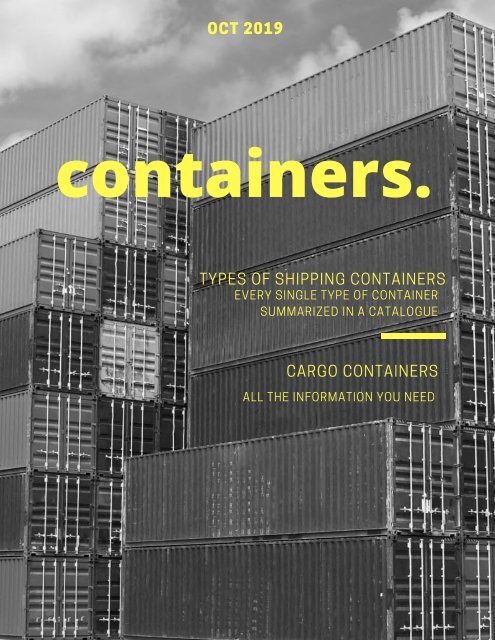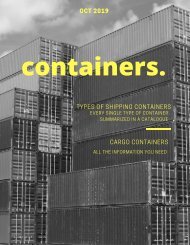CONTAINERS canva
containers
containers
You also want an ePaper? Increase the reach of your titles
YUMPU automatically turns print PDFs into web optimized ePapers that Google loves.
INDEX<br />
1.Dry storage<br />
container<br />
2. Flat rack container<br />
3. Open top<br />
container<br />
4. Tunnel container<br />
5. Open side storage<br />
container<br />
6. Double doors<br />
container<br />
7. Refrigerated ISO<br />
container<br />
8. Insulated or<br />
thermal container<br />
9. Tank
INDEX (II)<br />
10. Cargo storage<br />
roll container<br />
11. Half height<br />
container<br />
12. Car carrier<br />
container<br />
13. Intermediate<br />
bulk shift container<br />
14. Drums<br />
15. Swap bodies<br />
16. Flexitank<br />
17. Air cargo<br />
container
DRY STORAGE<br />
CONTAINER<br />
One of the most common used<br />
containers in the shipping industry.<br />
They can be 10, 20 or 40 feet long, and<br />
they are designed to transport dry<br />
goods, conserving them in a good<br />
condition. These containers are not<br />
suited for transporting food or<br />
chemicals that require refrigeration.
FLAT RACK<br />
CONTAINER<br />
Flat Rack container is suitable for the<br />
transport of heavy cargo, as well as goods<br />
that need a special load due to their<br />
dimensions, such as pipes and machinery.<br />
There are two models: with folding sides<br />
and with fixed sides. Flat Rack containers<br />
are made of steel and can be 20 feet and<br />
40 feet.
OPEN TOP<br />
CONTAINER<br />
Open top containers have removable<br />
<strong>canva</strong>s roof instead of a solid roof. They<br />
are specially designed for the transport<br />
of heavy or large loads. They usually<br />
have doors at the ends to give flexibility<br />
for loading and unloading operations.
TUNNEL<br />
CONTAINER<br />
These containers can be opened from<br />
both its ends, so the charge and<br />
discharge of the container becomes<br />
easier and faster. It can be loaded and<br />
unloaded from both ends of doors.<br />
Generally, the tunnel containers are<br />
available in 20 feet
OPEN SIDE STORAGE<br />
CONTAINER<br />
This type of container has one long side<br />
that can open completely. This is useful<br />
for merchandising that may be difficult<br />
to get inside the container.The side<br />
swings open as if it was made of two<br />
large doors, but it can still be secured to<br />
protect the merchandise inside.
DOUBLE DOOR<br />
CONTAINER<br />
Double door containers also have two<br />
doors, one on the end of the container<br />
and a large one along the side of the<br />
container. Much like a tunnel container,<br />
this style offers extra convenience when<br />
it comes to loading and unloading the<br />
container. The containers are made in<br />
20 and 40 foot lengths, and they are<br />
typically constructed with steel or iron.
REFRIGERATED ISO<br />
CONTAINER<br />
Refrigerated containers are big fridges that are used to<br />
transport temperature controlled cargoes such as fruits,<br />
meat, fish, seafood, vegetables, dairy and also also non-food<br />
products such as flowers, pharmaceuticals and film across<br />
many miles and oceans. Refrigerated units can maintain or<br />
lower the temperature of your shipment, even in the most<br />
difficult conditions. Important point to note is that a reefer<br />
unit is not designed to reduce the temperature of the cargo<br />
but rather to maintain the pre-cooled cargo temperature.<br />
Standard ISO shipping containers are 8ft (2.43m) wide, 8.5ft<br />
(2.59m) high and come in two lengths; 20ft (6.06m) and 40ft<br />
(12.2m).
THERMAL<br />
CONTAINER<br />
For thermal containers, the<br />
temperature is usually higher than the<br />
outside temperature. Insulated cargo<br />
containers come in the same standard<br />
sizes you find with other shipping<br />
containers, with the 20-foot and 40-foot<br />
lengths being the most common. They<br />
measure 8-feet, 6-inches high and 8-feet<br />
wide, typically with a double-door<br />
opening on one end that is<br />
approximately 7 feet, 4 inches high and<br />
7 feet wide.
TANK<br />
CONTAINER<br />
Tank containers are used for the<br />
shipment of gases or liquids, they are<br />
often used for the transportation of<br />
hazardous cargoes such as fuel and toxic<br />
substances. Tank containers must be<br />
filled to a minimum of 80% capacity and<br />
must not exceed 95% capacity, this is to<br />
allow sufficient space for thermal<br />
expansion whilst preventing dangerous<br />
surging of the liquids in transit. They are<br />
mostly made of strong steel or other<br />
anti corrosive materials providing them<br />
with long life and protection to the<br />
materials.
CARGO STORAGE<br />
ROLL CONTAINER<br />
This is one of the specialized container<br />
units made for purpose of transporting<br />
sets or stacks of materials. They are<br />
made of thick and strong wire mesh<br />
along with rollers that allows their easy<br />
movement.
Half height<br />
container<br />
The Half height container is designed to<br />
securely stack to save space, which is<br />
essential on a rig floor. Basket units<br />
feature load securing points with<br />
multiple internal tie-down points for<br />
safe and secure transport; and baskets<br />
can be supplied with a load protection<br />
cover to eliminate the risk of snagging<br />
cargo. Cargo restraining nets are also<br />
available and all baskets are designed to<br />
not slip or slide on rig floors or barges.
Car carrier<br />
container<br />
Car carrier containers are used to move<br />
cars by road, rail and by sea. Generally,<br />
this type of shipping arrangements are<br />
done to move cars and other<br />
automobiles by sea. Although the term<br />
car carrier container is used, almost all<br />
types of automobile vehicles can be<br />
transported in such containers by<br />
making necessary changes in<br />
manufacture.
Intermediate bulk<br />
shift container<br />
An intermediate bulk container (or IBC)<br />
is a pallet mounted, industrial grade<br />
reusable container that is used for<br />
storing and transporting bulk liquids<br />
and powders. Also known as a tote, the<br />
IBC is capable of stacking and can be<br />
moved by a pallet jack or forklift. There<br />
are three broad types of IBCs in use<br />
today that can be categorized under<br />
rigid, folding and flexible. The two most<br />
common volumes of the rigid IBC are 275<br />
gallons and 330 gallons.
Drums<br />
A drum is a cylindrical container used<br />
for shipping bulk cargo. Drums can be<br />
made of steel, dense paperboard<br />
(commonly called a fiber drum), or<br />
plastics, and are generally used for the<br />
transportation and storage of liquids<br />
and powders. Drums are often certified<br />
for shipment of dangerous goods. The<br />
most common drums are made of 18-<br />
gauge (0.048-inch, or 1.2-millimetre,<br />
thick) steel and contain 55 gallons (208<br />
litres).
Special purpose<br />
container<br />
Special purpose containers can be made<br />
in nearly any shape or dimension. They<br />
are used to transport items that require<br />
a custom container to be made for<br />
them. Most shipping companies avoid<br />
the use of special purpose containers as<br />
much as possible because they are<br />
costly to create and transport.<br />
Nevertheless, this is necessary for<br />
certain loads
Swap bodies<br />
container<br />
A swap body is a type of freight<br />
container used for road and rail<br />
transport. The size of these containers is<br />
standardized and they cannot be<br />
stacked. Folding legs under their frame<br />
is a typical characteristic of swap bodies.<br />
Due to the design of this type of<br />
container, fuel costs are lower; swap<br />
bodies minimise empty weight, so there<br />
is less ‘dead weight’ carried. This results<br />
in lower fuel consumption, and<br />
therefore cheaper transportation of<br />
goods.
Flexitank<br />
The flexitank, also called flexibag, is a large<br />
flexible bag or tank that transforms a<br />
conventional 20 feet container into a safe and<br />
efficient bulk liquid shipping system. It allows<br />
transporting between 10,000 and 24,000 liters,<br />
although the most common models are those of<br />
16,000, 18,000, 20,000, 22,000 and 24,000 liters.<br />
Generally, the model with the greatest capacity is<br />
chosen, but always taking into account the<br />
density of the product. In general, almost all types<br />
of non-hazardous liquid can be transported.
Air cargo<br />
container<br />
This container is used to load luggage,<br />
freight, and mail on wide-body aircraft<br />
and specific narrow-body aircraft. It<br />
allows a large quantity of cargo to be<br />
bundled into a single unit. Since this<br />
leads to fewer units to load, it saves<br />
ground crews time and effort and helps<br />
prevent delayed flights. Each container<br />
has its own packing list (or manifest) so<br />
that its contents can be tracked.




